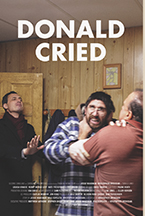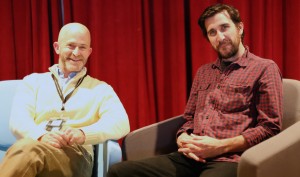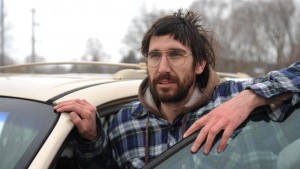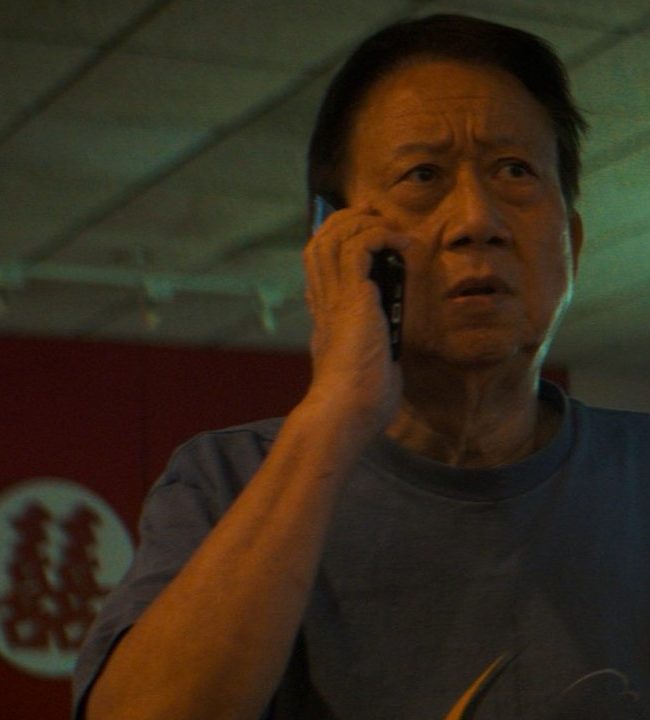A Conversation With Kris Avedisian (DONALD CRIED)
 I met with writer/director/actor Kris Avedisian at the Maryland Film Festival on Friday, May 6, 2016, to discuss his narrative feature Donald Cried, about an accidental reunion between two high-school friends grown very apart, which has been making the rounds of the film festivals (including SXSW, previously), and for which I also wrote a review. It was shot in Warwick, Rhode Island, where Avedisian is from. Here is a condensed digest of that conversation.
I met with writer/director/actor Kris Avedisian at the Maryland Film Festival on Friday, May 6, 2016, to discuss his narrative feature Donald Cried, about an accidental reunion between two high-school friends grown very apart, which has been making the rounds of the film festivals (including SXSW, previously), and for which I also wrote a review. It was shot in Warwick, Rhode Island, where Avedisian is from. Here is a condensed digest of that conversation.
Hammer to Nail: Your feature is an adaptation of a short film, of the same name, that you made in 2012. What was the inspiration for that original story?
KA: One of my collaborators, Kyle [Espeleta], he had the idea that he wanted to get Jesse [Wakeman] and me together, because we’ve all been working together for the past 15 years. So just as a fun thing to do, he wanted to get us together and have us play two old friends who hadn’t seen each other in some time. We were going to be at a diner, talking, catching up, and he wasn’t going to give us each other’s background, just our own characters, and we weren’t going to know anything about each other. So it was just kind of a fun idea he had.
At the time, I was trying to write some low-budget features, to get one made, and so, needing to do something, since it had been a while, I took Kyle’s idea, and wrote the short. So we just shot that short over the course of a weekend. That was kind of the genesis, this idea of the straight man and the weirdo.
HtN: So Kyle had the idea, and you guys ran with it.
KA: Yeah. And Donald came from…you know, I was thinking of weirdos, and doing voices as I would be driving along and stuff, and came up with Donald that way. And then I had kind of the basic premise of the movie, the annoying bit, the unknown. And then the whole idea was to have that one turn, where your empathies – or sympathies – switched, and Donald became something else. The short was more about the audience’s arc, rather than either of these characters’. So then when people saw it, and were pulling more out of it than we expected, and were really relating to Donald and Peter, I thought, well, all right, then this could be the feature that I was looking for.
HtN: And this is your first feature, right?
KA: Yes.
HtN: And I’m glad you mention that moment where the audience’s allegiances shift, because I found that an especially interesting part of the film. So now that we’ve discussed the origin story, could you discuss the process of adapting it to a feature? You said that the audience response to the short helped with that. Also, how did you get the funding?
KA: So we were working on the story and then got going on the script, and probably did that for a year and then started looking for a producer. The thing that was difficult with the script was keeping that same kind of audience arc, and something that could happen realistically over a 24-hour period, and not have that main character make huge changes in his life, yet still be affected. So it was just going back and forth between over-the-top movie world and then boring reality and kind of me in the middle. It took 3 years to find Kyle Martin, who produced the movie, but it really allowed the story to reach its full potential. I mean, there’s probably still even a better version of it, of course, but…
So my wife’s cousin had seen the short and was really into it. He went out to Slamdance just to kind of check out the scene. He’s a fireman and a landscaper and everything, and he had a little bit of investment money around and he was the one to initially support the movie, financially.
HtN: Did you do a Kickstarter campaign or Indiegogo or something like that?
KA: We did Kickstarter for the backend…
HtN: For the post…
KA: Yeah, for the post and everything.
HtN: Talking about the adaptation, in the feature, you make Peter Latang more of a jerk. I found watching the short interesting, because he is not as nasty to Donald.
KA: Yeah, well, the short was so short, and he was serving as the straight man and sort of, like, the bouncing board, that sort of more audience arc than character arc kind of thing. So, with the feature, we wanted, again, not to create this strong character and leave it open to interpretation and for people to come and bring their own experiences of going home and everything. And, you know, at one point, we wondered if he was going to be an alcoholic, or…how much of a character do we make of this guy? And we just erred on the side of…it’s this guilt that makes him act the way he does. He’s not really a jerk, he just gets there and it starts drumming up all these things. I think that good people can misbehave. And that’s really all it is. They both misbehave, in their own way.
HtN: So you said that you’ve known Jesse for 15 years. Your rapport is part of what makes the film so strong. Had you just known him for a while, or had you worked with him before? Because Jesse Wakeman and Kris Avedisian are the movie.
KA: We met in California 15 years ago through Kyle Espeleta. And we’ve just been making things together. The short was the first time we were in something together. He’s usually the one doing the acting for me. We’re just really close. And as we’ve gotten older we’ve started living our own lives a little, but we’re still in constant contact, and still kind of working things out, in our different ventures. A lot of my thing is really annoying him. Very much like I’m doing in the movie…
HtN: He’s your Bobby De Niro.
KA: (laughs) Yeah…So I spend a lot of time annoying my friends in a Donald-like way. So this was a good opportunity to cash in on that practice.
HtN: And the rest of the cast, are they local Warwick, Rhode Island, residents?
KA: Some. Like a lot of the extras and these second-tier level guys are friends who have been in stuff before, like the guy who plays “The Godfather” was in the short, and he’s a good friend. The football guys, the same thing: the one, main guy was in the short, as well. And then everyone else was cast out of Boston, except for Louisa [Krause]. She’s in New York. She was friends with Kyle Martin, the producer.
HtN: So the film is beautifully shot. It looks as if it were made on a higher budget than I’m sure it was. It’s just really well shot. Can you talk about your DP [cinematographer]?
KA: Yeah, the DP is Sam Fleischner, and he directed a movie called Stand Clear of the Closing Doors. I had been talking to him. He was friends with Jesse. They had known each other, both being in New York. He wanted to get involved. And we only had 11 days to shoot, so it was trying to strike a balance with what we were trying to accomplish, and not going to big with it. We shot a lot of two-camera stuff.
HtN: What did you shoot on? Just curious…
KA: The [Sony] FS7. I haven’t always liked Sony cameras, but I was really happy with this one. Yeah, so he was coming off a thing, doing some vérité kind of stuff, and everything, and he wanted to do things in longer takes. He kind of brought that, and it was easier to set up on these kinds of longer takes.
HtN: And double the coverage in a short amount of time. Which can also be a problem.
KA: Right. But the two cameras definitely helped because of the improv that could happen, and yes, speed.
HtN: So you were shooting in your home state. Would you recommend that, for indie filmmakers, shooting where you’re from, in terms of ease of production?
KA: Oh, yeah, absolutely. You save on location scouting, because you probably know all these spots. Sam was from Providence, as well, so he knew that whole part of us being in the woods. I knew that they were going to go up to a fort, and he had known about that train tunnel, which I knew existed, but didn’t know how to get access to. That was his thing. The fort ended up being set inside there.
So things like that, and then I knew the road where Jesse’s grandmother and my house were located. We had found the grandmother’s house on that road, and the next-door neighbor had come out when we were looking, and was wondering what we were doing, and kind of protecting his neighborhood a little bit, but then he ended up playing the cab driver in the film, and kind of became our locations manager for that street, and got us the other places. Just that type of connection that you just wouldn’t get if you were a stranger.
HtN: Right, because they’re, like, he’s the hometown guy, and we’re going to help him out.
KA: And then just having friends to fill the benefit [in the film]. We threw a real cancer benefit. In fact, I couldn’t believe we got as few people as we did, because usually, you throw something in Warwick and everyone comes out, but I think it was Valentine’s Day weekend and stuff. But yeah, that kind of support, when people know you’re from the area, they’re just that more likely to help.
HtN: Final question. In both the short and the feature, the streets are covered with a lot of snow. You got lucky both times.
KA: (laughs) It’s amazing!
HtN: What time of year were you shooting?
KA: They were both in February, and they both were, like, record years. With the short, we shot over just a weekend, and it had snowed just a few days before, and it was exceptionally cold, so the snow stuck around. And over the course of the years leading up to the feature, we looked into other states that would have snow, because snow became such an important thing. You know: you’re trapped and it’s just more claustrophobic and it’s less open. So that was very important. And then we just said, screw it, there was nothing we could do, and we just had to go for it. And literally three days before we started shooting, it just started to dump, and it just kept going throughout the whole production. And it’s just amazing, because there are some inconsistencies, but very few. We really lucked out. That was really a blessing.
HtN: The gods smiled down on you …
KA: Yeah, because it really changes the movie. If it was raining or just overcast, it wouldn’t be the same.
HtN: No, it wouldn’t. Well, congratulations. It’s a great film. I really enjoyed it.
KA: Thank you very much.
– Christopher Llewellyn Reed (@ChrisReedFilm)













